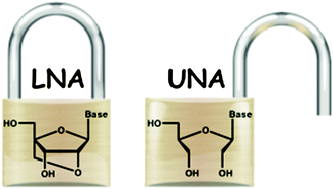Locked vs. unlocked nucleic acids (LNAvs.UNA): contrasting structures work towards common therapeutic goals†
Abstract

- This article is part of the themed collection: Advances in DNA-based nanotechnology
* Corresponding authors
a
Nucleic Acid Center, Institute for Physics and Chemistry, University of Southern Denmark, Campusvej 55, 5230 Odense M, Denmark
E-mail:
jwe@ifk.sdu.dk
Fax: +45 6615 8760
Tel: +45 6550 2510

 Please wait while we load your content...
Something went wrong. Try again?
Please wait while we load your content...
Something went wrong. Try again?
M. A. Campbell and J. Wengel, Chem. Soc. Rev., 2011, 40, 5680 DOI: 10.1039/C1CS15048K
To request permission to reproduce material from this article, please go to the Copyright Clearance Center request page.
If you are an author contributing to an RSC publication, you do not need to request permission provided correct acknowledgement is given.
If you are the author of this article, you do not need to request permission to reproduce figures and diagrams provided correct acknowledgement is given. If you want to reproduce the whole article in a third-party publication (excluding your thesis/dissertation for which permission is not required) please go to the Copyright Clearance Center request page.
Read more about how to correctly acknowledge RSC content.
 Fetching data from CrossRef.
Fetching data from CrossRef.
This may take some time to load.
Loading related content
